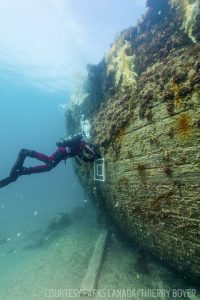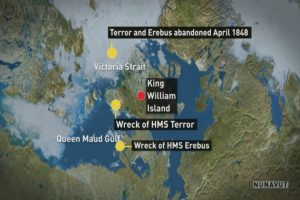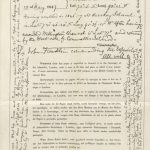Above – HMS Terror shipwreck
In my previous blog (The Terror of The Terror), I shared with you my minor obsession with the doomed saga of The Franklin Expedition in a 19th century search for the Northwest Passage in the HMS Terror and HMS Erebus. Let’s go to the end of the story and work our way back. The British Admiralty launched several failed rescue missions starting in 1848 and some went on for 33 years.
In 2014, archaeologists and Inuit historians found the HMS Erebus in Victoria Strait. Two years later, the HMS Terror was found in Terror Bay on the southwestern coast of King William Island. But what happened to the crew? Some communications left by Captain Crozier and Commander James Fitzjames (Captain of the Erebus) and second in command of the expedition upon Franklin’s death was found in Cairns, but the official ships logs were never found. The wrecks of the Terror and Erebus are in relatively shallow water and in good shape, most likely due to the frigid water temperatures. The sites are protected and being preserved with artifacts being recovered.
But what happened? There are several theories. Imagine my glee when I stumbled across a paper by Zane Horowitz (Oregon Health & Science University) on “Polar Poisons: Did Botulism Doom the Franklin Expedition?”. I’m a toxicologist by training and now a mystery/thriller author. The story of The Terror combines mystery/suspense with history, a wee bit of the supernatural and toxicology. It is truly my perfect story!
Let’s unpack what we know.
- The HMS Terror and HMS Erebus were state of the art and very well provisioned to feed 134 men for three years, including 32,224 pounds of salt beef, 36,487 pounds of biscuits, 20,463 pints of soup, 8900 pounds of preserved vegetables, 9260 pounds of lemon juice (to combat scurvy), 3684 gallons of concentrated spirits and 4980 gallons of ale and other alcohol beverages.
- The provider of the canned goods for the expedition was Stephan Goldner (the lowest bidder), who a few years later would be caught in a scandal regarding his canned foods for naval ships going rancid. One theory is that the majority of the expedition’s canned food went bad, resulting in them loosing a significant portion of their food supply.
- On May 19, 1845, Erebus and Terror left England and sailed for the west coast of Greenland, where five men were discharged due to illness, bringing the total crew number to 129. On July 26, the expedition met two British whaling ships, the Enterprise and the Prince of Whales – the last Europeans to see the Franklin expedition alive.
- The Erebus and Terror continued west and wintered on Beechey Island where three crewmembers died and were buried in the permafrost. The bodies were exhumed (and reburied) in the 1980s for forensic testing in order to shed light on what may have happened.
- On September 12, 1846, the sea froze around the Erebus and Terror just north of King William Island, signaling the start of winter. The crew left messages in a cairn detailing events to this point.
- The sea in this region usually froze in late August or early September and then broke up the following spring, but in 1847, spring and summer never came and Erebus and Terror found themselves trapped and drifting helplessly with the pack ice.
- By spring 1848, both ships remained stuck in the ice. Captain Franklin and several officers and crew had died of currently unknown causes. Crozier was now in command with Fitzjames as his second-in-command. The men were reaching the end of their original food supply. They decided to abandon Erebus and Terror in a desperate attempt at survival. They hoisted smaller boats on sledges, packed them full of provisions and set off in search of rescue. They returned to the cairn where they had left a note a year earlier; where Crozier and Fitzjames updated their status (see below). The remaining crew set off for Back’s Fish River, which led to a Hudson’s Bay Company trading post, but this goal was hundreds of miles away over a vast artic wasteland.
- In 1854, a Hudson’s Bay Company surveyor met with several Inuit near King William Island and asked if they had seen white men or ships. The Inuit told of seeing about 40 survivors marching south dragging a boat on a sledge. The Inuit also reported that later during the 1850 season they encountered the corpses of some 30 persons and some graves. The Hudson’s Bay Company report states, “From the mutilated state of many of the bodies, and contents of the kettles, it is evident that our wretched countrymen had been driven to the last dread alternative as a means of sustaining life.” Cannibalism
- Forensics backs up this gruesome finding. In the 1980s and 1990s, bones of crewmembers were found and showed signs of heating and breakage and being cracked open to obtain the fat-rich bone marrow. The conclusion was undeniable evidence of cannibalism.
- In 1859 a British search expedition found a trail of bones and other evidence along the southwestern coast of King William Island. A boat with two skeletons and supplies was found, along with the cairn where they retrieved Crozier’s and Fitzjames’ note – the sole piece of written evidence from the Franklin expedition.
- The first explorer to navigate the Northwest Passage by ship, the goal of the Franklin expedition, was Roald Amundsen in 1903 – 1906.
- In 2014, archaeologists and Inuit historians located the wreck of the Erebus in Victoria Strait and in 2016; a separate group located the wreck of the Terror in Terror Bay.
What could have happened to the crews of the HMS Terror and HMS Erebus?
o High levels of lead were found in the tissue and bones of all three crew buried on Beechey Island. Some have suggested that the lead solder used to seal the expedition’s canned provisions had leached into the food resulting in neurological impairment and possibly death.
o Could Botulism, type E, which is endemic in the Arctic, have contributed to crew deaths? In theory the Botulism could have come from improperly prepared canned foods or from eating contaminated local fish and game.
o Or was the fate of the crew a combination of horrors; lead poisoning, botulism, scurvy, tuberculosis, zinc deficiency, Addison’s Disease, exposure, starvation, cannibalism?
- One last tale persisted in some remote Inuit corners. That one white man, an ‘‘eshmuta,’’ was aided by the Inuk and survived. Romantics like to think that young, Captain Crozier, the ‘‘eshmuta’’ leader of that final brave death march south, the most experienced Arctic explorer alive at that time, was that sole survivor. Will we ever know?
↓ Location of HMS Terror & HMS Erebus abandonment and shipwrecks
← Facsimile of Crozier & Fitzjames note found in cairn
For Further Reading:
- The Terror by Dan Simmons – 2007
- Frozen in Time: The Fate of the Franklin Expedition by Owen Beattie by John Geiger – 2017
- Captain Francis Crozier: Last Man Standing? by Michael Smith – 2006
- Sir John Franklin’s Erebus and Terror Expedition: Lost and Found by Gillian Hutchinson – 2017
- Polar Poisons: Did Botulism Doom the Franklin Expedition? A. Horowitz; Journal of Toxicology. Clinical Toxicology 41 (6): 841-847, February 2003



I am reading the book right now & find it fascinating !!